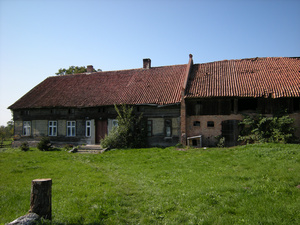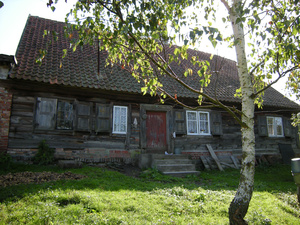|
gm. Ryjewo, pow. kwidzyński, woj. pomorskie
(Do 1945 roku Schweingrube, Tragheimerweide, Zwanzigerweide)

Within the boundaries of the present town there existed three settlements: Schweingrube, Tragheimerweide i Zwanzigerweide. In the period from the 16th till the 18th century, they were part of the Sztum starosty, in the Malbork voivodship, while in the Prussian period, they were subordinated to the poviat of Sztum of the Kwidzyn Regency. All of them were merged into one rural unit in 1928.
Settlement Schweingrube - in 1740, Michał Bieliński, the starost of Sztum granted 84 ha of land to Mennonites. In 1758, Tekla Bielińska leased some of the land for 30 years to settlers: Heinrich Nickel, Gils Ewert and Hans and Henrich Ewarts. Around 1760, there also appeared an inn, Krug Schweingrube (which became part of Schweingrube village in the 19th century). In 1770, Franciszek Bieliński renewed the contract for the next 30 years with settlers: Hans Markwart, Abraham Zels, Henrich Pauls, Peter Peters, Franz Gerz, Abraham Penner.
Settlement Tragheimerweide - in 1664, mentioned as pastures leased to the Dutch settlers from Tragamin. In 1713, 9 Mennonites settled here. In 1744, the settlement was completely settled with Mennonites. Settlement Zwanzigerweide - mentioned in 1765, when Tekla Bielińska leased the land to Mennonites for 30 years. In 1892, the village was merged with Tragheimerweide.
In the place called Barcice there was a Mennonite commune. In the beginning, it was identified with Schweingrube, and since about 1820, with Tragheimerweide. In the years 1892-1929, the name Zwanzigerweide was in use. In 1728, the Bishop of Chełm issued a permit for erection of a prayer house. Another one, made in brick, was erected in 1866. Unfortunately, it has not been preserved till today. In the 1950-ties, in the village there existed historical buildings: homestead No. 2 of 1844, No. 14 of 1859, No. 34 of 1787, No. 35 of 1874, and No. 103 dated to the second half of the 18th century.
A village situated on the right bank of the Vistula, in the northern part of the Kwidzyn lowlands, about 10 km south-west of Sztum. A village consisting of three detached settlements arranged on a layout of rows and also irregularly. The cultural landscape has been preserved in a good condition. The arrangement of homesteads, fields and drainage ditches and forestation has been insignificantly transformed.
Two wooden homesteads have survived till today:
 No. 16 dated to the end of the 19th century, and No. 20 of 1856. Two cemeteries have been preserved, one at the entry to the village, on a man-made land elevation. The other one is situated in the forest. No. 16 dated to the end of the 19th century, and No. 20 of 1856. Two cemeteries have been preserved, one at the entry to the village, on a man-made land elevation. The other one is situated in the forest.



B. Schmid, Die Bau–und Kunstdenkmäler der Prowinz Westpreussen, Bd. 3, H. 13, Kreis Stuhm, Danzig 1909,s. 325; Opis królewszczyzn w województwach chełmińskim, pomorskim i malborskim w roku 1664, wyd. J. Paczkowski, Fontes 32, TNT, Toruń 1938, s. 142; H. Wiebe, Das Siedlunkswerk niederländischer Mennoniten im Weichseltal zwischen Fordon und Weissenberg bis zum Ausgang des 18. Jahrhunderts, Marburg 1952, s. 40; J. Stankiewicz, Zabytki budownictwa i architektury na Żuławach, „Rocznik Gdański”, t. 15-16, Gdańsk 1956–1957, s. 527.
|

 No. 16 dated to the end of the 19th century, and No. 20 of 1856. Two cemeteries have been preserved, one at the entry to the village, on a man-made land elevation. The other one is situated in the forest.
No. 16 dated to the end of the 19th century, and No. 20 of 1856. Two cemeteries have been preserved, one at the entry to the village, on a man-made land elevation. The other one is situated in the forest. 

